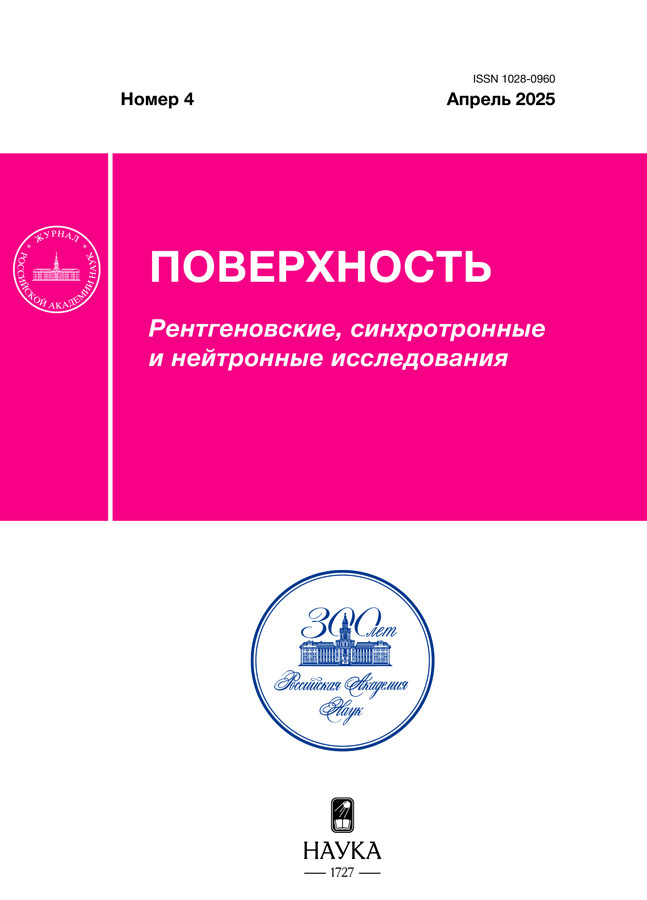Study of SiO2 films obtained by PECVD and doped with Zn
- Authors: Privezentsev V.V.1, Firsov A.A.1, Kulikauskas V.S.2, Zatekin V.V.2, Kirilenko E.P.3, Goryachev A.V.3
-
Affiliations:
- National Research Centre “Kurchatov Institute” — Scientific Research Institute for System Analysis
- Lomonosov Moscow State University, Skobeltsyn Institute of Nuclear Physics
- Institute of Nanotechnology of Microelectronics RAS
- Issue: No 4 (2025)
- Pages: 70-74
- Section: Articles
- URL: https://modernonco.orscience.ru/1028-0960/article/view/689195
- DOI: https://doi.org/10.31857/S1028096025040106
- EDN: https://elibrary.ru/FCFSZP
- ID: 689195
Cite item
Abstract
The results of studying silicon oxide films obtained by plasma enhanced chemical vapor deposition on Si substrates are presented. They were implanted with 64Zn+ ions with an energy of 50 keV (dose 7 × 1016 cm–2) and then annealed in oxygen atmosphere at elevated temperatures. It has been found that after implantation, zinc is distributed in the SiO2 film according to the normal law with a maximum of about 40 nm. After implantation, zinc is in the silicon oxide film both in the metallic phase (closer to the film surface) and in the oxidized state (in the film depth). After annealing up to 800°C, the zinc profile shifts into the film depth; in this case, the zinc is in the film only in the oxidized state. At high temperatures (over 800°C), the zinc profile shifts toward the film surface.
Full Text
About the authors
V. V. Privezentsev
National Research Centre “Kurchatov Institute” — Scientific Research Institute for System Analysis
Author for correspondence.
Email: v.privezentsev@mail.ru
Russian Federation, Moscow
A. A. Firsov
National Research Centre “Kurchatov Institute” — Scientific Research Institute for System Analysis
Email: v.privezentsev@mail.ru
Russian Federation, Moscow
V. S. Kulikauskas
Lomonosov Moscow State University, Skobeltsyn Institute of Nuclear Physics
Email: v.privezentsev@mail.ru
Russian Federation, Moscow
V. V. Zatekin
Lomonosov Moscow State University, Skobeltsyn Institute of Nuclear Physics
Email: v.privezentsev@mail.ru
Russian Federation, Moscow
E. P. Kirilenko
Institute of Nanotechnology of Microelectronics RAS
Email: v.privezentsev@mail.ru
Russian Federation, Moscow
A. V. Goryachev
Institute of Nanotechnology of Microelectronics RAS
Email: v.privezentsev@mail.ru
Russian Federation, Moscow
References
- Старостин В.В. Материалы и методы нанотехнологий. М.: БИНОМ, 2015. 434 с.
- Litton С.W., Collins T.C., Reynolds D.S. Zinc Oxide Material for Electronic and Optoelectronic Device Application. Chichester: Wiley, 2011.
- Neshataeva E., Kümmell T., Bacher G., Ebbers A. // Appl. Phys. Lett. 2009. V. 94. P. 091115. https://doi.org/10.1063/1.3093675
- Chu S., Olmedo M., Yang Zh. et al. // Appl. Phys. Lett. 2008. V. 93. P. 181106. https://doi.org/10.1063/1.3012579
- Smestad G.P., Gratzel M. // J. Chem. Educ. 1998. V. 75. P. 752. https: j.chem.wisc.edu.
- Li C., Yang Y., Sun X.W., Lei W., Zhang X.B., Wang B.P., Wang J.X., Tay B.K., Ye J.D., Lo G.Q., Kwong D.L. // Nanotechnology. 2007. V. 18. P. 135604. https://doi.org/10.1088/0957-4484/18/13/135604
- Mehonic A., Shluger A.L., Gao D., Valov I., Miranda E., Ielmini D., Bricalli A., Ambrosi E., Li C., Yang J.J., Xia Q., Kenyon A.J. // Adv. Mater. 2018. V. 30. 43. P. 1801187. https://doi.org/10.1002/adma.201801187
- Sirelkhatim A., Mahmud S., Seeni A., Kaus N.H.M., Ann L.C., ohd Bakhori S.K., Hasan H., Mohamad D. // Nano-Micro Lett. 2015. V. 7. P. 219. https://doi.org/10.1007/s40820-015-0040-x
- Inbasekaran S., Senthil R., Ramamurthy G., Sastry T.P. // Intern. J. Innov. Res. Sci. Eng. Technol. 2014. V. 3. P. 8601. www.ijirset.com.
- Straumal B.B., Mazilkin A.A., Protasova S.G., Myatiev A.A., Straumal P.B., Schütz G., van Aken P.A., Goering E., Baretzky B. // Phys. Rev. B. 2009. V. 79. P. 205206. https://doi.org/10.1103/PhysRevB.79.205206
- Ilyas N., Li C., Wang J., Jiang X., Fu H., Liu F., Gu D., Jiang Y., Li W. // J. Phys. Chem. Lett. 2022. V. 13 (3). P. 884. https://doi.org/10.1021/acs.jpclett.1c03912
- Qin F., Zhang Y., Guo Z. et al. // Mater. Adv. 2024. V. 5. P. 4209. https://doi.org/10.1039/d3ma01142
- Okulich E.V., Okulich V.I., Tetelbaum D.I., Mikhaylov A.N. // Mater. Lett. 2022. V. 310. P. 131494. https://doi.org/10.1016/j.matlet.2021.131494
- Mehonic A., Gerard T., Kenyon A.J. // Appl. Phys. Lett. 2017. V. 111. P. 233502. https://doi.org/10.1063/1.5009069
- Chang K.C., Tsai T.M., Chang T.C., Wu H.H., Chen J.H., Syu Y.E., Chang G.W., Chu T.J., Liu G.R., Su Y.T., Chen M.C., Pan J.H., Chen J.Y., Tung C.W., Huang H.C., Tai Y.H., Gan D.S., Sze S.M. // IEEE Eelecron. Dev. Lett. 2013. V. 34 (9). P. 399. https://doi.org/10.1109/LED.2013.2241725
- Privezentsev V.V., Kulikauskas V.S., Zatekin V.V., Kiselev D.A., Voronova M.I. // J. Surf. Invest.: X-ray, Synchrotron Neutron Tech. 2022. V. 16 (3). P. 402. https://doi.org/ 10.1134/S1027451022030314
- Hofmann S. Auger- and X-Ray Photoelectron Spectroscopy in Material Science. Berlin Heidelberg: Springer–Verlag, 2013.
- Анализ поверхности методами оже- и рентгеновской фотоэлектронной спектроскопии / Ред. Бриггс Д., Сих М.П. М.: Мир, 1987. 600 с.
- Монахова Ю.Б., Муштакова С.П. // Журнал аналитической химии. 2012. Т. 67. Вып. 12. С. 1044.
- SIMNRA code. https://mam.home.ipp.mpg.de/
- Ziegler J.F., Biersack J.P. SRIM 2013 (http://www.srim.org).
Supplementary files















